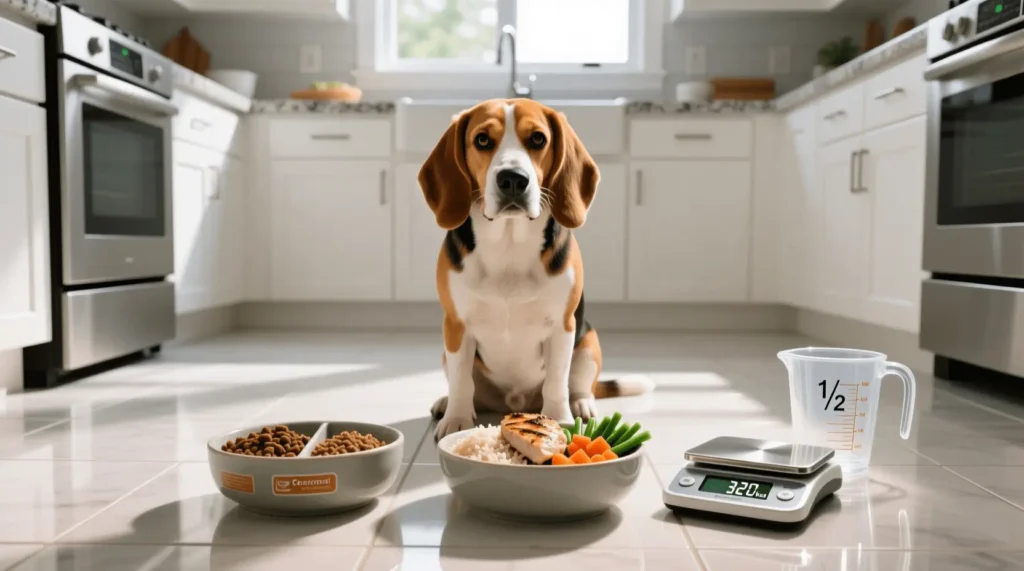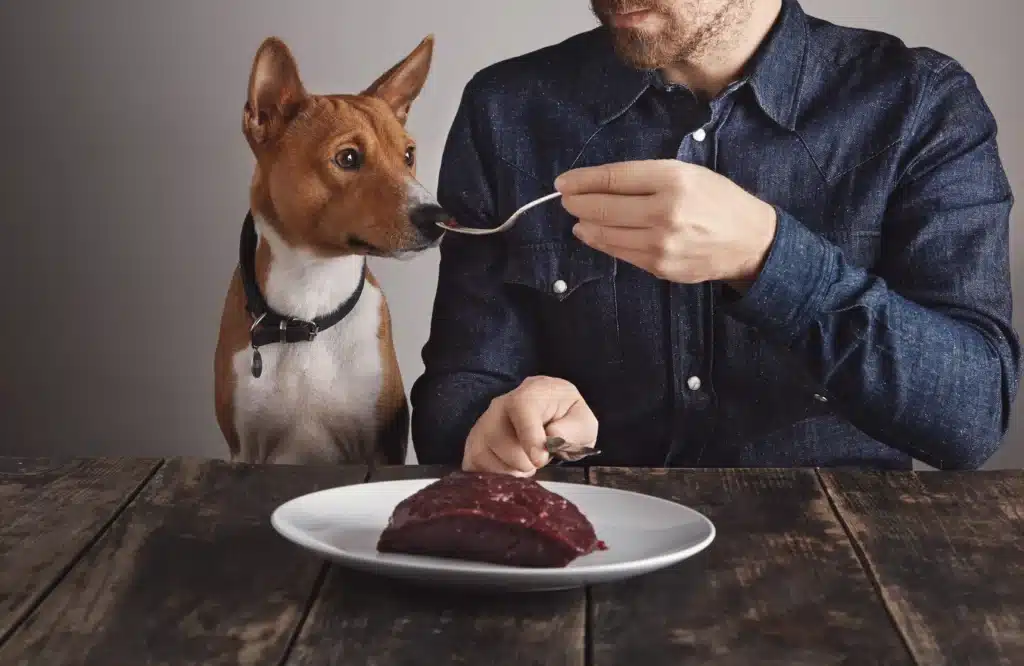Feeding your puppy properly isn’t just about keeping them full , it’s about building the foundation for a lifetime of health.
Balanced nutrition in puppyhood affects metabolism, immune resilience, bone density, and even brain development.
Yet “How much should I feed my puppy?” remains one of the most common , and confusing , questions for dog owners. Every puppy grows at a different rate, burns energy differently, and has unique nutritional needs depending on breed size, age, and activity level.
This guide combines expert insights from the American Animal Hospital Association (AAHA 2021), the World Small Animal Veterinary Association (WSAVA 2023), and leading research from Cornell University (2024) to help you feed with confidence , not guesswork.
Puppy Feeding Basics: Why Measured Meals Work Best
Veterinarians agree that measured feeding , serving pre-portioned meals at fixed times is the healthiest approach.
Leaving food out all day (free-choice feeding) may seem convenient, but it often leads to overeating, obesity, and unpredictable digestion. A measured schedule helps you track appetite, monitor stool quality, and detect early signs of illness such as decreased interest in food.
Benefits of measured feeding
- Prevents weight gain and digestive stress.
- Builds routine bathroom habits.
- Makes it easier to notice appetite or energy changes.
Feeding Frequency by Age
Puppies’ metabolism and digestion change rapidly during the first year. Here’s a general schedule vets recommend:
| Age | Meals per Day | Details |
| 6 – 12 weeks | 4 | Tiny stomachs, high metabolism → four small meals; use moistened kibble or wet food. |
| 3 – 6 months | 3 | Appetite stabilizes; portion control prevents “chubby puppy” weight gain. |
| 6 – 12 months | 2 | Transition to twice-daily meals for steady energy. |
| Over 12 months | 1 – 2 | Adult routine; large breeds may stay on 2 smaller meals. |
Large and giant breeds (Labs, Great Danes, Mastiffs) benefit from maintaining 2–3 smaller meals longer, it reduces bloating and joint strain.
How Much to Feed: Calorie-Based Approach
Step 1 , Calculate Resting Energy Requirement (RER)
Formula: RER = 70 × (weight in kg)^0.75
Then multiply by the growth factor:
- 2–4 months: × 3
- 4–12 months: × 2
Example: A 10-lb (4.5 kg) puppy
→ RER = 70 × (4.5)^0.75 = 218 kcal/day
At 3 months = 218 × 3 ≈ 650 kcal/day

Step 2 , Adjust for Body Condition Score (BCS)
- Ribs easily felt but not visible → Ideal
- No waistline → Overfed
- Visible ribs → Underfed
Each puppy may need ± 20–50 % adjustment depending on activity and metabolism.
Step 3 , Track Weekly
Weigh weekly; growth should be steady, not sudden. Rapid weight gain, especially in large breeds, can increase orthopedic risk.
Average Calorie Chart (adapted from PetMD)
| Ideal Weight | Under 4 Months | Over 4 Months |
| 5 lb | ~ 392 kcal | ~ 261 kcal |
| 10 lb | ~ 649 kcal | ~ 433 kcal |
| 20 lb | ~ 1,100 kcal | ~ 734 kcal |
| 30 lb | ~ 1,487 kcal | ~ 991 kcal |
| 40 lb | ~ 1,843 kcal | ~ 1,229 kcal |
| 50 lb | ~ 2,160 kcal | ~ 1,456 kcal |
These are averages; adjust by ± 50 % based on breed, energy level, and BCS.
Is It Worth Buying Expensive Puppy Food?
Many new pet owners wonder if premium or “super-premium” puppy food is actually worth the higher cost. In most cases, it is — and here’s why.
High-quality puppy foods have greater nutritional density and more stable ingredient sourcing. This means your puppy gets more energy and balanced nutrients from smaller portions, supporting healthy growth and digestion. As a result, you often feed less while getting better results, including firmer, smaller stools.
Premium brands also invest heavily in research, feeding trials, and quality control. Studies from the American Animal Hospital Association (AAHA, 2021) and Journal of Animal Science (2022) show that nutrient consistency and digestibility in well-formulated diets help maintain steady growth and reduce the risk of deficiencies.
Cheaper foods can vary from batch to batch, which may upset sensitive puppies or cause uneven growth. Paying more for a reputable brand usually means better quality, more reliability, and fewer long-term health issues making it a smart investment for your puppy’s development.
Should I Feed My Puppy Dry Food, Wet Food, or Both?
Every puppy is different, and there’s no single “best” food type for all. What matters most is that the food is complete, balanced, and approved by AAFCO for growth or all life stages.
Dry Food (Kibble)
Dry food is the most affordable and practical option. It helps keep teeth cleaner and provides consistent nutrition. You can soften it with warm water or unsalted broth for very young puppies, though it’s not necessary once they adjust.
Wet Food (Canned)
Wet food is more aromatic and appealing, which makes it helpful for picky eaters or recovering puppies. It’s higher in moisture but also higher in cost per calorie. Always ensure it says “complete and balanced” on the label.
Combination Feeding
Mixing both dry and wet foods offers balance — dry food for dental health and wet food for taste and hydration. You can alternate meals (kibble in the morning, wet food at night) as long as total calories stay within your puppy’s daily needs.
Alternative Diets (Fresh, Freeze-Dried, Dehydrated, or Raw)
Alternative diets can work when properly formulated, but many homemade food or raw diets options lack essential nutrients or may harbor bacteria. Always consult your vet before switching. The FDA Center for Veterinary Medicine (2024) advises that raw diets should be handled carefully due to contamination risk.
Whether you choose dry, wet, or a mix, the priority is a nutritionally complete, vet-approved diet that suits your puppy’s breed, lifestyle, and digestion.
Nutrients That Drive Healthy Growth
1. Protein and Amino Acids
Puppies need 22–32 % protein (dry matter). Key amino acids: Arginine, Taurine, Lysine, Methionine.
High-quality protein builds lean muscle and supports immune function.
2. Fats and Omega-3 Fatty Acids
Fat provides energy and essential vitamins (A, D, E, K).
Omega-3s (EPA, DHA) enhance brain and eye development , studies show DHA-supplemented pups learn tasks faster.
3. Calcium and Phosphorus
Keep Ca:P ratio around 1.2–1.4:1.
Excess calcium can cause skeletal deformities in large-breed dogs.
4. Vitamins & Micronutrients
Copper, Zinc, Selenium, Vitamin D support bone and immune health.
Deficiencies can cause anemia or coat loss.
| Fact | Details | Source |
|---|---|---|
| Puppies’ energy requirement | Puppies require approximately twice the energy per pound compared to adult dogs | NRC, 2006 |
| Effect of DHA-supplemented diets | Improved visual learning by 30% in puppies | JAVMA, 2020 |
Small vs Large Breed Feeding Differences
Small breeds (< 25 lb adult) reach adult size by 9–12 months. They burn calories quickly and need more calories per pound.
Large/Giant breeds (> 50 lb adult) grow for 15–24 months; require controlled calorie and mineral intake to avoid joint issues.

Choosing the Right Puppy Food
When reading labels, look for these markers of quality:
AAFCO statement: “Formulated for growth or all life stages.”
Feeding trials conducted: Proof of digestibility & safety.
Named animal protein source: Chicken, lamb, salmon , not “meat by-product.”
Transparency: Companies that publish nutrient analyses and employ board-certified nutritionists.
Avoid DIY or raw diets unless supervised by a veterinary nutritionist; most homemade plans are deficient in essential minerals and vitamins.
Recent studies show some grain-free or “boutique” diets may contribute to canine dilated cardiomyopathy (DCM).
Sample Feeding Schedule
| Time | Meal | Notes |
| 6:30 AM | Breakfast | Post-morning walk meal. Keeps blood sugar steady. |
| 12:30 PM | Lunch | Midday portion with light exercise after. |
| 6:30 PM | Dinner | Main feed; maintain same volume each day. |
| 9:30 PM | Optional Snack | Only for high-energy or very young puppies. |
Use an automatic feeder if away from home. Keep fresh water available at all times and wash bowls daily to prevent bacterial film.
Treats, Human Food & Feeding Mistakes
- Treats ≤ 10 % of daily calories.
- Avoid table scraps; onions, garlic, grapes, chocolate, xylitol are toxic.
- Don’t over-reward after absence , which may reinforce separation anxiety.
- Introduce diet changes gradually to avoid GI upset.
When to Consider Special Diets
According to WSAVA Global Nutrition Guidelines 2023 special formulas or prescription diets are used for:
- Digestive disorders
- Heart or kidney disease
- Metabolic conditions
- Allergies or food sensitivities
Never add vitamin or mineral supplements without vet approval , excess nutrients can be toxic.
Transitioning to Adult Food
During switching from puppy to adult dog food, monitor stool consistency, appetite, and hydration. Gradual transitions allow your puppy’s gut microbiome to adjust without gastrointestinal upset.
Consider including vet-approved probiotics or digestibility-tested diets for sensitive stomachs.
Once your puppy reaches ≈ 80–90 % of expected adult weight:
- Small breeds: 10–12 months
- Medium breeds: 12–15 months
- Large breeds: 18–24 months
Switch gradually over 7–10 days:
- 75 % puppy + 25 % adult food
- 50 / 50 mix
- 25 % puppy + 75 % adult food
When to Call Your Vet
- Sudden weight loss or gain
- Vomiting, diarrhea, or flatulence after diet change
- Lethargy or refusal to eat
- Persistent scratching or skin irritation (possible food allergy)
Your vet can adjust calorie targets and recommend prescription formulas if needed.
Key Takeaways
- Feed measured, timed meals instead of free-choice.
- Base portions on weight + body condition, not just bag charts.
- Choose AAFCO-approved growth diets from brands that employ nutritionists.
- Adjust food weekly as your puppy grows.
- Maintain 2–3 small meals for large breeds through adolescence.
- Consult your veterinarian for a custom feeding plan.


